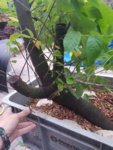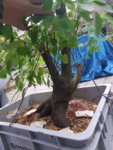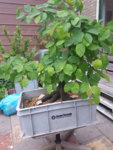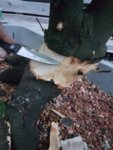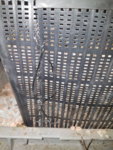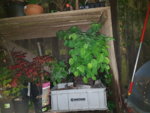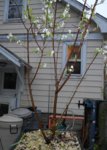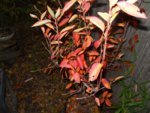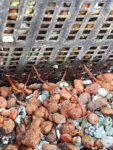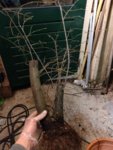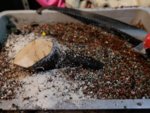Autumn 2015, myself and 8 other members of the bonsai study group I belong to, the Arbor Arts collective, we all bought Amelanchier x grandiflora, we all got the same cultivar. The goal was we each would use our individual techniques to turn them into bonsai. The cultivar was one selected to be more tree like rather than shrub like, though most of the pots had multiple trunks, usually 3. Other Amelanchier at the nursery had closer to a dozen stems in a pot, so our selections were more tree like.
So I can report, in many ways this is a wonderful species for bonsai. Superb winter hardiness, flowering not affected by late frosts, even though it flowers quite early, before Redbud (Cercis) with Forsythia. I have not had to provide any temperature protection, just set the pot on the ground, and you are good to -20 F (-28 C). The smooth gray bark is reminiscent of beech or hornbeam. Really nice. All our trees had at least one trunk over 1 inch diameter (over 2.5 cm) a bit too thin for bonsai but getting close enough that beefing a tree up during training should be possible.
Amelanchier are in the apple family, susceptible to all the diseases that apples can carry, however, as a group they seem much more disease resistant than most crab apples. Nobody in the group has had to spray them in the 2.5 years we've had them. They in theory could catch all the known apple diseases. they do seem resistant.
Roots, they seem to put out roots much like an apple. However they seem more reluctant to root cuttings. Several of us tried rooting cuttings off branches we trimmed, and no luck. (none of us used bottom heat or mist systems) This may suggest ground or air layering will be slower than an apple, but none of us have done a ground layer. For the ground layer above, I would not even look for roots until after first frost in autumn. I would probably just leave the set up intact until autumn 2019 or early spring 2020. Growth will tell you if it took. If it returns to rapid growth, similar to pre-ground layer growth rate, it has most likely put out roots. With the known tendency for the species to produce suckers, and spread by suckers, I have to assume they will indeed produce roots on any part of the trunk that is buried. But it might not be as quick as one or two months.
They are apples relatives, deciduous, they definitely like some organic in their potting mix. The AAC member who put theirs in all inorganic have reported poorer growth than those of us who used a richer medium with at least 25 % or more organics. This is in spite of the fact that we have seen them wild in some fairly barren soils. The species forms are common in the sand counties of northern lower peninsula of Michigan, common in Wisconsin sand counties too.
We have found that the books are right, they are slow to ''trunk up'', none of us have reported much diameter change in our trunks since purchase. Some thickening, but not a large amount. I am working on getting my fairly sparse tree in an Anderson flat to get bush, it is happening, but somewhat slowly. It set quite a bit of fruit this year. They do stop flowering after being trunk chopped. Those of us who chopped ours right away still have no flowers 3rd growing season. I kept one tall, chopped on low right away. The tall one blooms nicely even after serious root work. Chop victim has yet to bloom. They do not produce blooming spurs they way culinary apples do.
So all in all, I think it is a good species for bonsai, with high potential to make nice specimens. With the slow trunk development, probably best for sizes that finish below 3 feet tall (below 1 meter). Likely good for shohin and next size up bonsai. Leaves are naturally a little smaller than a crab apple, and with work should reduce nicely. Spring flowers come in early, normally pure white, and open before apples, about the time plums and cherries open. Autumn color is nice, yellows blending to oranges and reds. Fruit ripens early, locally late June or early July. Flavor is interesting, like apple with almond, you eat the fruit seeds and all. Texture is a little dry, being touted as a ''super fruit'' or the ''the next big hit at the farmer's markets'', but frankly it is just mild and bland enough I doubt it will really take off as a market fruit.
View attachment 193169
View attachment 193170
View attachment 193171
View attachment 193172





